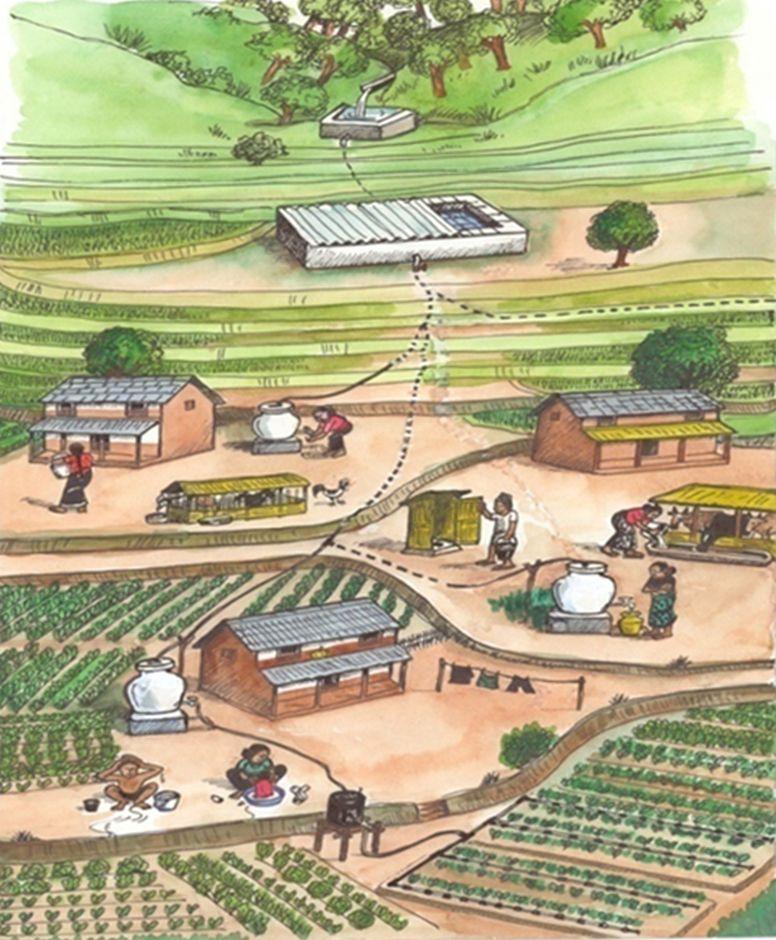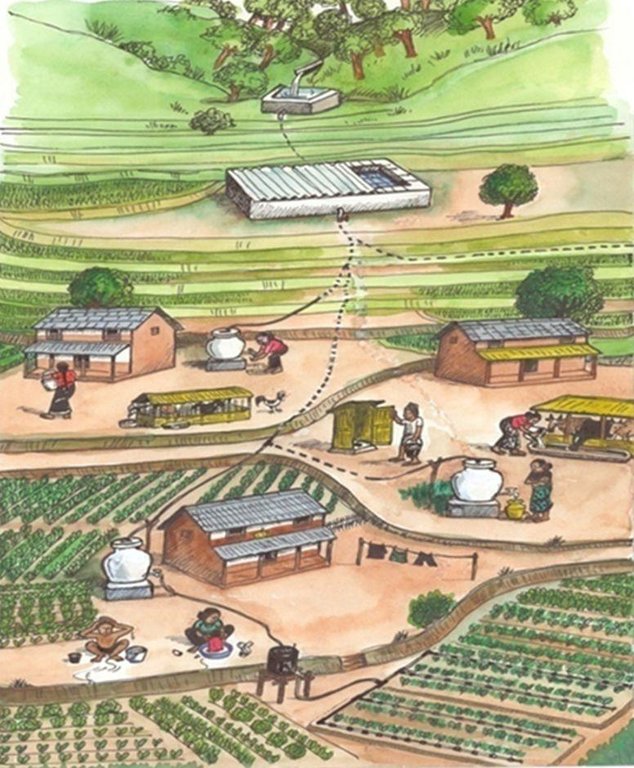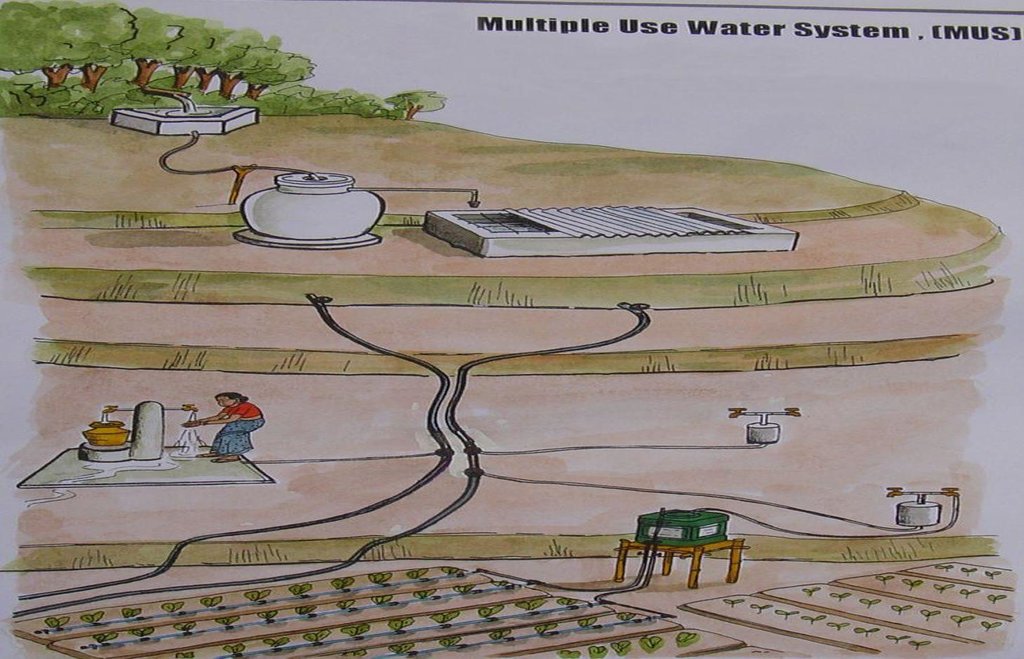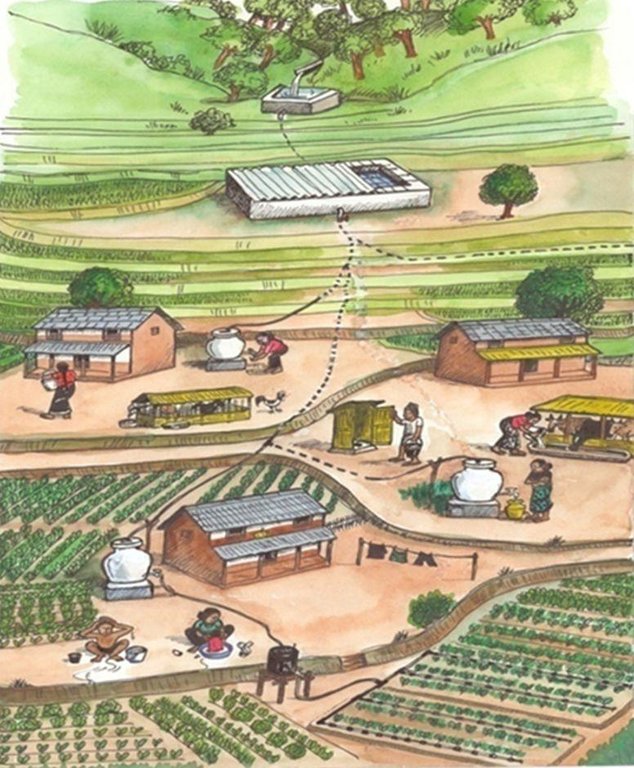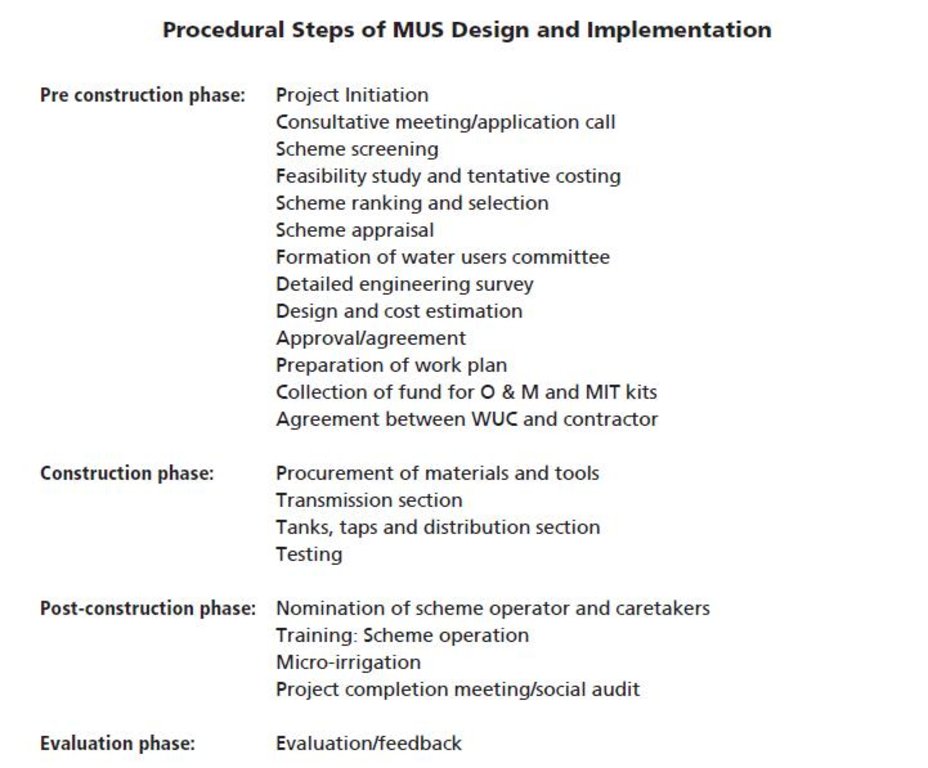A multiple-use water system [尼泊尔]
- 创建:
- 更新:
- 编制者: Shreedip Sigdel
- 编辑者: –
- 审查者: Fabian Ottiger
Bahu uddhasaya Pani prayog pranali (Main contributor: Parmananda Jha, IDE/Nepal)
approaches_2532 - 尼泊尔
查看章节
全部展开 全部收起1. 一般信息
1.2 参与方法评估和文件编制的资源人员和机构的联系方式
SLM专业人员:
Jha Parmananda
98487 28274 / 97495 12791 (M)
pjha@idenepal@org / jhap-2003@yahoo.com
Food Security Project, Regional Office, Banke Bagiya, Shantinagar,Nepalgunj
尼泊尔
有助于对方法进行记录/评估的机构名称(如相关)
iDE Nepal (iDE Nepal) - 尼泊尔有助于对方法进行记录/评估的机构名称(如相关)
ICIMOD International Centre for Integrated Mountain Development (ICIMOD) - 尼泊尔1.3 关于使用通过WOCAT记录的数据的条件
(现场)数据是什么时候汇编的?:
01/03/2013
编制者和关键资源人员接受有关使用通过WOCAT记录数据的条件。:
是
2. SLM方法的描述
2.1 该方法的简要说明
A multiple-use water system gives a community access to water for domestic use and water for crop irrigation.
2.2 该方法的详细说明
该方法的详细说明:
Aims / objectives: A multiple-use water system (MUS) is a combined water facility that has proven useful as a means of providing drinking water and water for irrigation for smallholder farmers in the hilly areas of Nepal. Water is collected by gravity from a highland source into a holding tank and is shared by means of distribution lines, domestic tap stands, and irrigation off-take lines. It can also support application of micro-irrigation technologies (MIT) such as drip and micro sprinkler irrigation systems.
Methods: MUS is a community-managed system that caters mainly to smallholder landowners and marginal households in rural hilly areas. When properly implemented, it can help to alleviate poverty and increase food security for poor and marginalized groups. The first priority is to provide drinking water and water for domestic use to the community; any excess water is used for agriculture and irrigation.
Stages of implementation: The following points should be taken into consideration before a community establishes a MUS:
• The source of water should be clear of water-rights issues
• The water should be plentiful and of good quality
• There needs to be a sufficient drop in gradient between the source and the tank if the water is to be collected by gravity. If the drop is not sufficient, users should be prepared to consider lifting the water.
• The distance between the source and the village should be less than 3 km.
• The community should be ready to contribute unskilled labour as part of their contribution to the project.
• The community should be ready to put aside some funds for operational and maintenance costs; these funds can, in part, also be collected in the form of monthly users' fees.
• At least 70% of the water users should be ready to adopt micro-irrigation technologies (MIT) such as drip and sprinkler irrigation.
2.3 该方法的照片
2.5 采用该方法的国家/地区/地点
国家:
尼泊尔
有关地点的进一步说明:
Kaski, Lamjunj, Tanahun, Dhading, Sangjya, Gulmi, Arghakhanchi, Palpa, Udayapur, Pyuthan, Rolpa, Ruk
2.7 方法的类型
- 基于项目/方案
2.8 该方法的主要目的/目标
The Approach focused mainly on other activities than SLM (Collect water from a small-scale source and distribute it both for domestic use and for the production of vegetables and high value crops)
• To provide a regular supply of water for domestic and agricultural use
• To supply water for micro-irrigation technologies such as drip and sprinkler irrigation systems
• To improve health and sanitation
• To help smallholder landowners improve their incomes and livelihoods as well as to adapt to climate change by having access to a regular supply of water so that they can grow crops regardless of changes
• To conserve water by using it more wisely
The SLM Approach addressed the following problems: The community needs to prioritize how it will partition the water for domestic use and for irrigation.
2.9 推动或妨碍实施本办法所适用的技术的条件
社会/文化/宗教规范和价值观
- 阻碍
Management and operation of system
Treatment through the SLM Approach: Strong social mobilization is needed
法律框架(土地使用权、土地和水使用权)
- 启动
The existing land ownership, land use rights / water rights helped a little the approach implementation: Since this approach uses small spring sources of water, there is usually only a minimum risk of conflict for water use. When the water source is registered with the local authorities, it helps to reduce potential conflicts over water rights between communities.
了解SLM,获得技术支持
- 阻碍
Water supply insufficient to meet the demand
Treatment through the SLM Approach: Increase the capacity of the storage tank
其他
- 阻碍
The community often cannot agree whether to scale up the domestic or the irrigation water supply.
Treatment through the SLM Approach: Concerned stakeholders need to confer and agree
3. 相关利益相关者的参与和角色
3.1 该方法涉及的利益相关者及其职责
- 当地土地使用者/当地社区
This included women, men, dalits, janjati, brahmin, chhetri
- SLM专家/农业顾问
- 教师/学龄儿童/学生
- NGO
IDE Nepal
- 国家政府(规划者、决策者)
3.2 当地土地使用者/当地社区参与该方法的不同阶段
| 当地土地使用者/当地社区的参与 | 指定参与人员并描述活动 | |
|---|---|---|
| 启动/动机 | 互动 | The community comes to a consensus on their water needs. They identify a source that it is within the 3 km limit and investigate the water use rights. |
| 计划 | 自我动员 | Technical aspects are dealt with; these include assessing the source to verify whether it has an adequate supply of water, assessing different schemes (for intake, take off, tap stands, and the like), preparing a design and estimating the cost, and discussing funding. |
| 实施 | 自我动员 | A users' committee is formed and the community provides unskilled labour. Technical assistance is provided by INGOs/NGOs. |
| 监测/评估 | 自我动员 | The work is monitored by the users' committee but monitoring and evaluation of technical aspects are provided by INGOs/NGOs at different times during the project. |
| Research | 无 |
3.3 流程图(如可用)
3.4 有关SLM技术选择的决策
具体说明谁有权决定选择要实施的技术:
- 仅限土地使用者(自主)
解释:
The community discusses and makes a decision on the type of water supply system they would like and specifies how they would like to apportion water for domestic and agricultural use. They submit a proposal to the concerned authorities.
Decisions on the method of implementing the SLM Technology were made by mainly by land users supported by SLM specialists. Technical support is provided by IDE Nepal in collaboration with different national and international non-governmental organizations, government organizations, and local bodies.
4. 技术支持、能力建设和知识管理
4.1 能力建设/培训
是否为土地使用者/其他利益相关者提供培训?:
是
明确受训人员:
- 现场工作人员/顾问
- Community
培训形式:
- 农民对农民
涵盖的主题:
The approach provided training to the community through the users' committee, field staff, and an agricultural advisor. The local skilled body is trained during site visits. For the most part, information is transferred from farmer to farmer. Much of the training is hands-on.
4.2 咨询服务
土地使用者有权使用咨询服务吗?:
是
指明是否提供了咨询服务:
- 在固定中心
说明/注释:
An advisory service is provided for the land/water users, but what is given is usually insufficient to help farmers learn new techniques such as micro-irrigation.
4.3 机构强化(组织发展)
是否通过这种方法建立或加强了机构?:
- 是,适度
具体说明机构的强化或建立程度:
- 本地
具体说明支持类型:
- 能力建设/培训
提供进一步细节:
village development committees, local governance and community development programmes (LCGDP), community forest user groups, youth clubs, and women's groups. Village development committees can invest in MUS and micro-irrigation technologies as specified in their guidelines.
4.4 监测和评估
监测和评估是该方法的一部分吗?:
是
注释:
bio-physical aspects were regular monitored by project staff, land users through measurements; indicators: Project staff and land users routinely monitor the water source and other biophysical aspects to ensure that the approach remains sustainable.
technical aspects were regular monitored by land users through observations; indicators: Commercial vegetable or high value crop production, micro irrigation, drinking water and sanitation
socio-cultural aspects were ad hoc monitored through observations; indicators: MUS schemes help to improve sanitation and thereby reduce the incidence of waterborne diseases. They also help to improve livelihoods by making more fresh vegetables available both for immediate consumption and for sale.
economic / production aspects were monitored through observations; indicators: MUS schemes help to reduce drudgery; the labour saved can be used in the production of vegetables and other high value crops.
no. of land users involved aspects were monitored through measurements; indicators: From 10 to 80; on average 28 land users are involved in one MUS scheme
management of Approach aspects were monitored through observations; indicators: Participatory approach with collaboration by government organizations, INGOs/NGOs and others to provide routine inspections and technical support
There were no changes in the Approach as a result of monitoring and evaluation: The approach, as it is now put into practice, is a result of incorporating technological improvements that were originally identified through years of monitoring and evaluation.
There were no changes in the Technology as a result of monitoring and evaluation
4.5 研究
研究是该方法的一部分吗?
是
明确话题:
- 技术
提供进一步的细节,并指出是谁做的研究:
IDE has researched and implemented this type of MUS concept, system design, and methodology in Nepal since 2003; now other agencies also provide similar systems.
Research was carried out both on station and on-farm
5. 融资和外部物质支持
5.1 该方法中SLM组成部分的年度预算
如果不知道准确的年度预算,请给出一个范围:
- 10,000-100,000
注释(例如主要的资助来源/主要捐助者):
Approach costs were met by the following donors: international non-government: 30.0%; local government (district, county, municipality, village etc): 26.0%; local community / land user(s): 44.0%
5.2 为土地使用者提供财政/物质支援
土地使用者是否获得实施该技术的财政/物质支持?:
是
如果是,请具体说明支持的类型、条件和提供者:
All MUS systems in Nepal are built by communities or community groups in collaboration with the government and NGOs. The fact that MUS systems provide multiple benefits is seen as a plus point for institutions looking to invest in community projects.
5.3 对特定投入的补贴(包括劳动力)
如果土地使用者的劳动力是一项重要的投入,那么是不是:
- 以现金支付
注释:
Unskilled labour is provided by the community; skilled labour is provided by the implementing organization. The implementing organization pays for both the skilled and unskilled labour.
Materials that are available locally are contributed by the community. Materials that are not available locally are paid for out of project funds. Equipment, tools, and specialist materials are purchased through collaborative partners. Training programmes aimed at capacity building and upgrading skills are subsidized.
5.4 信用
是否根据SLM活动的方法给予信用值?:
否
6. 影响分析和结论性陈述
6.1 方法的影响
该方法是否帮助土地使用者实施和维护SLM技术?:
- 否
- 是,很少
- 是,中等
- 是,支持力度很大
The approach supports sustainable land management because micro- irrigation technologies promote optimal use of water and help to retain nutrients in the soil. Similarly, the production of high value crops and vegetables further increases the fertility of the soil.
该方法是否有助于社会和经济弱势群体?:
- 否
- 是,很少
- 是,中等
- 是,支持力度很大
The wellbeing of marginalized and socio-economically disadvantaged groups improves significantly.
Did other land users / projects adopt the Approach?
- 否
- 是,很少
- 是,中等
- 是,支持力度很大
Since the reduction in drudgery and the improvements in livelihoods are so great, many communities would like to implement this approach. INGOs/NGOs can help with the financial and technical aspects of implementation.
Did the Approach lead to improved livelihoods / human well-being?
- 否
- 是,很少
- 是,中等
- 是,支持力度很大
This approach helps to reduce drudgery and to improve sanitation; overall, it improves livelihoods and contributes to human wellbeing. It also increases the production of crops, and helps to conserve the soil and improve its fertility.
Did the Approach help to alleviate poverty?
- 否
- 是,很少
- 是,中等
- 是,支持力度很大
Through increased income from the production of vegetables and high value crops
6.2 土地使用者实施SLM的主要动机
- 增加生产
- 增加利润(能力),提高成本效益比
- well-being and livelihoods improvement
6.3 方法活动的可持续性
土地使用者能否维持通过该方法实施的措施(无外部支持的情况下)?:
- 是
若是,请说明如何维持:
Since the approach was requested by the community as a whole, they all have a vested interest in seeing that it remains sustainable. When technical support is needed, it can be obtained from the concerned agencies.
6.4 该方法的长处/优点
| 编制者或其他关键资源人员认为的长处/优势/机会 |
|---|
| A reliable water supply for both the domestic and irrigation needs of hill farmers (How to sustain/ enhance this strength: The continued involvement of the community, the government, and assisting INGOs/NGOs.) |
| The MUS is a simple gravity system that does not require either sophisticated equipment or training. (How to sustain/ enhance this strength: Continue to investigate how it can be simplified even further) |
| A MUS system has a minimum lifespan of ten years and is easy to install even in remote areas. (How to sustain/ enhance this strength: Continue to investigate how it can be improved even further) |
| MUS is well suited to the dual purpose use of water for both domestic and agricultural use. (How to sustain/ enhance this strength: Continue research and development to see how it can be improved even further.) |
6.5 该方法的弱点/缺点以及克服它们的方法
| 编制者或其他关键资源人员认为的弱点/缺点/风险 | 如何克服它们? |
|---|---|
| Installation costs can be a challenge for very poor communities. It can only irrigate small areas (0.1-0.15ha). | Installation costs can usually be recovered within 1 year when the irrigation water is used to produce high value crops. |
| The intake and reservoirs need to be inspected regularly. | Either devise a means to ensure that inspections are conducted regularly or find a system that requires fewer inspections |
| Reservoir tanks and intake pipes can deteriorate over time and pipes and joints can start to leak. | Local skilled labour can be employed to carry out needed repairs. Pipes and fittings should be checked regularly. Routine inspection and maintenance are essential. |
| Costs can be high when imported materials are needed for repair and maintenance. | At the outset, some money needs to be set aside for operation and maintenance costs; additional funds should be collected by charging monthly users' fees. |
7. 参考和链接
7.1 方法/信息来源
- 实地考察、实地调查
- 与土地使用者的访谈
7.2 参考可用出版物
标题、作者、年份、ISBN:
Multiple use water service implementation in Nepal and India: Experience and lessons for scale-up, Mikhail, M; Yoder, R (2008)
可以从哪里获得?成本如何?
http://www.ideorg.org/OurStory/IDE_multi_use_water_svcs_in_nepal_india_8mb.pdf
链接和模块
全部展开 全部收起链接
无链接
模块
无模块


